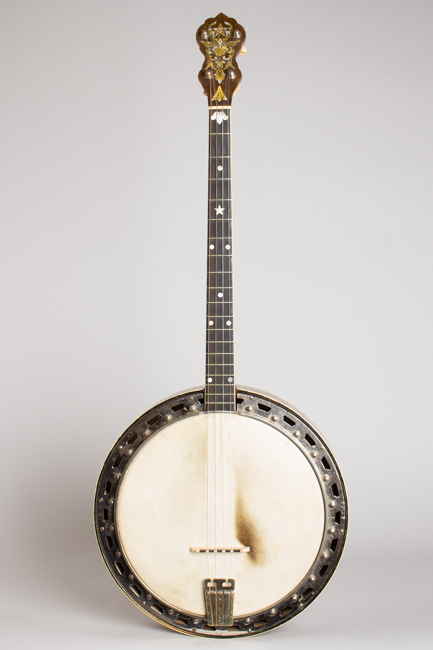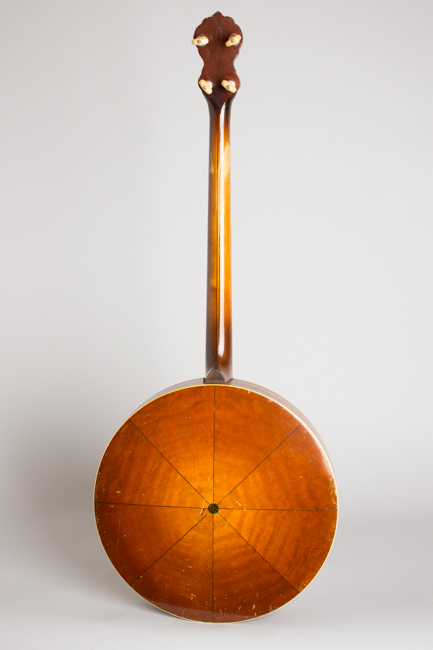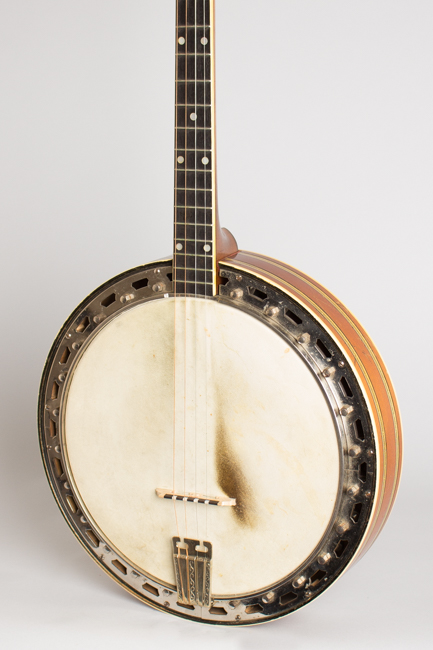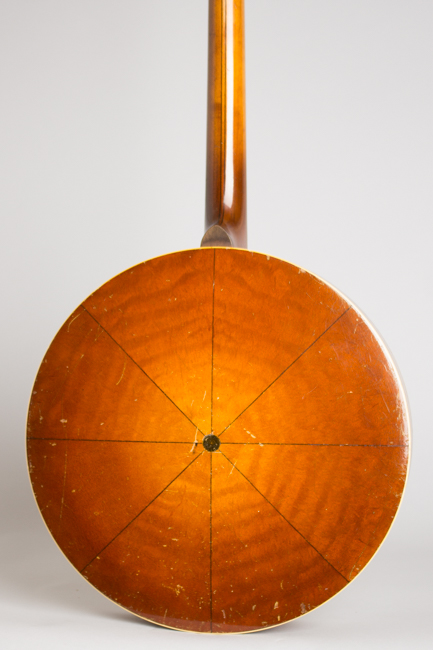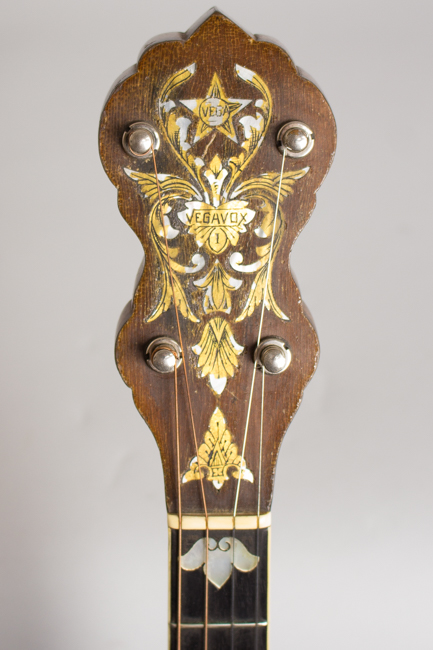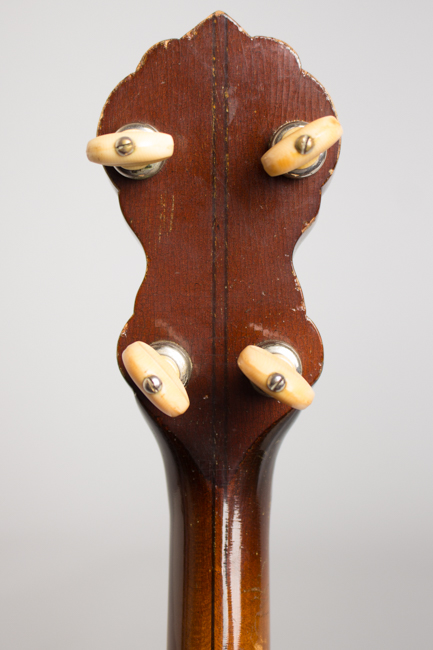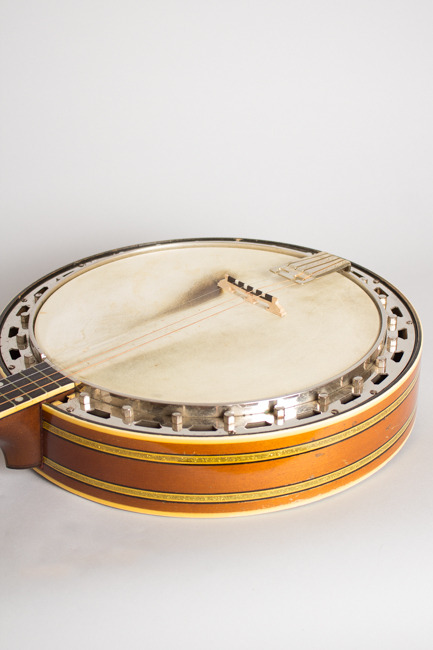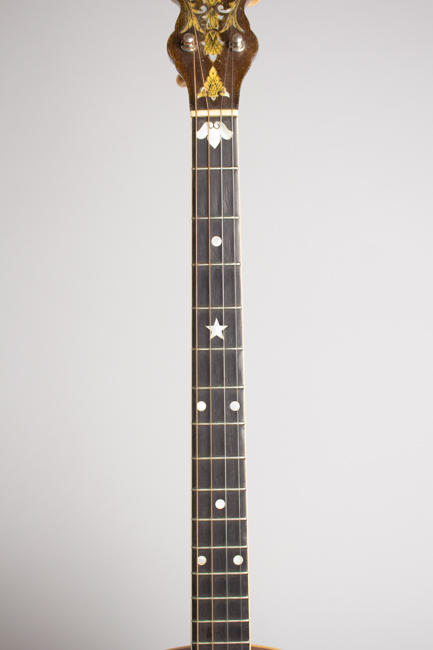Vega Vegavox I Tenor Banjo (1930)
This item has been sold.
Item # 8038
Prices subject to change without notice.
Vega Vegavox I Model Tenor Banjo (1930), made in Boston, Mass., serial # 93615, shaded maple finish, laminated maple neck, rim and resonator, ebony fingerboard, black hard shell case.
This fairly early Vegavox I is a nice example of Vega's final development of the tenor banjo family, which even today remains one of the most sought-after of the breed. The Vegavox models appeared at the end of the 1920s, when interest in the tenor banjo was already fading. With their industry-standard Vegaphone line, Vega was arguably the most successful banjo maker of the era, and they weren't going down without a fight!
Developed with input from plectrum virtuoso Eddie Peabody, the Vegavox used the same rim design mounted in a very deep resonator totally enclosing it with the flange mounted just under the head. The tension nuts were adjusted from the top, a design pioneered earlier by Leedy and Ludwig and eventually adopted by Gibson in the 1930s.
The Vegavox line were exclusively high-end professional banjos. This Vox 1 was the simplest model of four styles offered but is still rather fancy. The fingerboard inlay is similar to the earlier Vegaphone Professional, while the elaborate pearl headstock pattern is more like the high-end Artist model. The deep-dish resonator is finished in Vega's subtle shaded maple, with a pie-section back and two thick inlaid lines of celluloid and gold sparkle inlay on the sides. The top-tension nuts and flange is chrome-plated.
The sound is very powerful (the Vegavox is built on the Tub-A-Phone rim) with a deeper dimension than most tenor banjos. Many players who worked as soloists or with small combos preferred the Vegavox to all earlier tenors, and Vega continued to make them -- in small numbers -- up into the late 1960s. This is a lovely early-pattern example and still an exceptionally fine tenor banjo for any application.
Overall length is 33 3/4 in. (85.7 cm.), 11 in. (27.9 cm.) diameter head, and 3 1/4 in. (8.2 cm.) in depth, measured at side of rim. Scale length is 23 in. (584 mm.). Width of nut is 1 1/8 in. (29 mm.).
This banjo shows light-moderate wear overall, but the only alteration is a lovely handmade repro tailpiece; the originals often have failed from metal fatigue by now. There is some wear to the finish on the back of the neck from play, and dings and chips to the resonator sides and back. The frets and fingerboard also show some wear, but the instrument still plays very well with the expected superlative sound.
A fine player's example of this fairly rare and much-lauded tenor banjo; includes a later Vega HSC sized for a plectrum/5-string length neck, but otherwise a good fit. Very Good + Condition.
This fairly early Vegavox I is a nice example of Vega's final development of the tenor banjo family, which even today remains one of the most sought-after of the breed. The Vegavox models appeared at the end of the 1920s, when interest in the tenor banjo was already fading. With their industry-standard Vegaphone line, Vega was arguably the most successful banjo maker of the era, and they weren't going down without a fight!
Developed with input from plectrum virtuoso Eddie Peabody, the Vegavox used the same rim design mounted in a very deep resonator totally enclosing it with the flange mounted just under the head. The tension nuts were adjusted from the top, a design pioneered earlier by Leedy and Ludwig and eventually adopted by Gibson in the 1930s.
The Vegavox line were exclusively high-end professional banjos. This Vox 1 was the simplest model of four styles offered but is still rather fancy. The fingerboard inlay is similar to the earlier Vegaphone Professional, while the elaborate pearl headstock pattern is more like the high-end Artist model. The deep-dish resonator is finished in Vega's subtle shaded maple, with a pie-section back and two thick inlaid lines of celluloid and gold sparkle inlay on the sides. The top-tension nuts and flange is chrome-plated.
The sound is very powerful (the Vegavox is built on the Tub-A-Phone rim) with a deeper dimension than most tenor banjos. Many players who worked as soloists or with small combos preferred the Vegavox to all earlier tenors, and Vega continued to make them -- in small numbers -- up into the late 1960s. This is a lovely early-pattern example and still an exceptionally fine tenor banjo for any application.
Overall length is 33 3/4 in. (85.7 cm.), 11 in. (27.9 cm.) diameter head, and 3 1/4 in. (8.2 cm.) in depth, measured at side of rim. Scale length is 23 in. (584 mm.). Width of nut is 1 1/8 in. (29 mm.).
This banjo shows light-moderate wear overall, but the only alteration is a lovely handmade repro tailpiece; the originals often have failed from metal fatigue by now. There is some wear to the finish on the back of the neck from play, and dings and chips to the resonator sides and back. The frets and fingerboard also show some wear, but the instrument still plays very well with the expected superlative sound.
A fine player's example of this fairly rare and much-lauded tenor banjo; includes a later Vega HSC sized for a plectrum/5-string length neck, but otherwise a good fit. Very Good + Condition.
